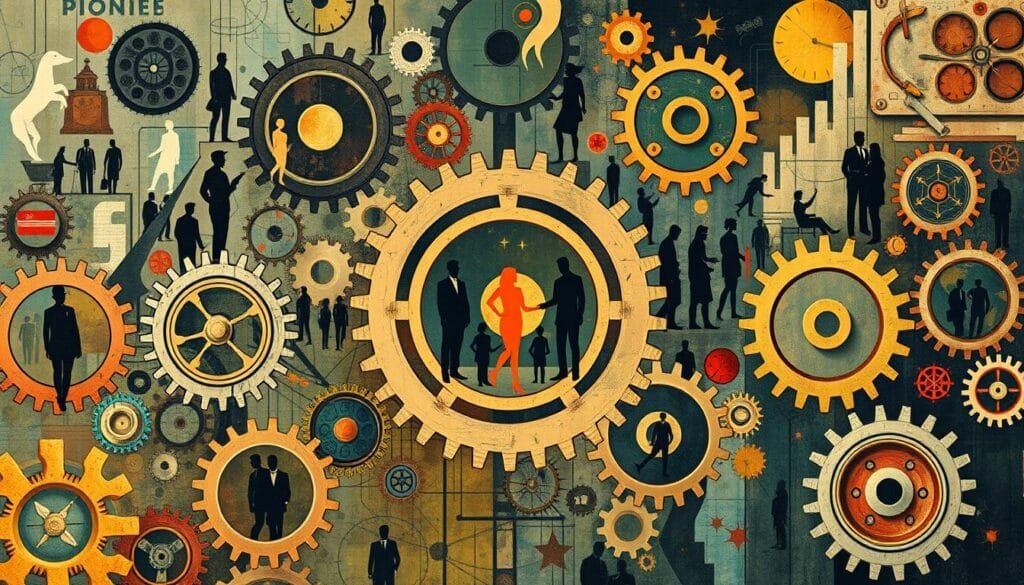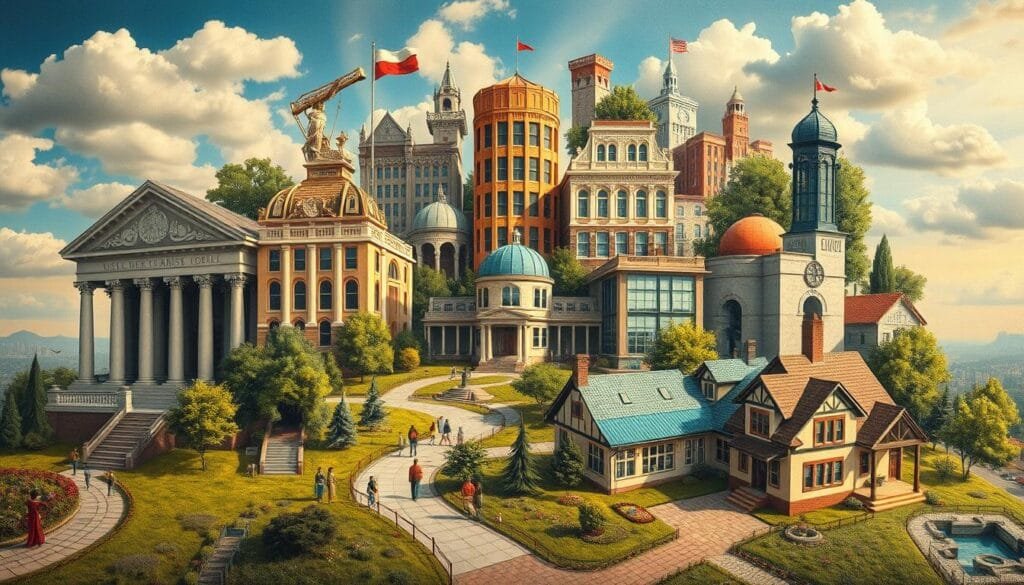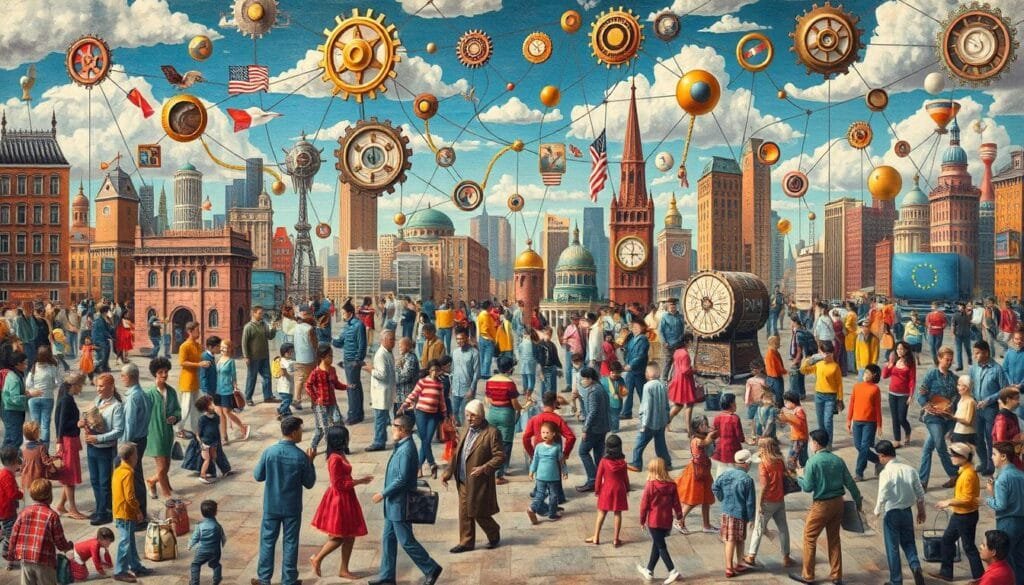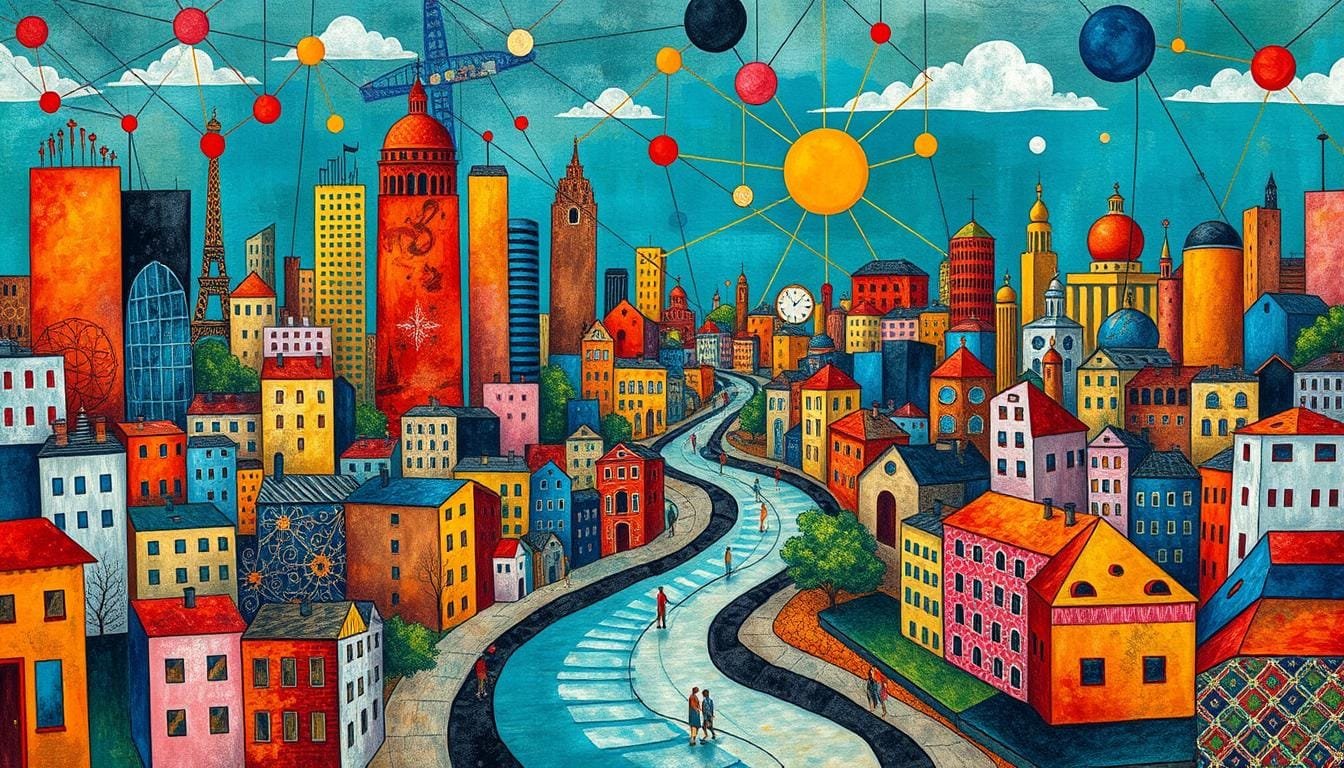Society is like a complex web made up of different people and their relationships. It’s not just a group of people. It also includes the traditions, institutions, and behaviors that shape how we act. This blend of elements forms the foundation of how we understand society.
Max Weber, a key sociologist, highlighted how society affects each person. He looked into social inequalities. He showed how different positions in society influence our experiences and roles. Peter L. Berger said, “The first wisdom of sociology is this—things are not what they seem.” This means we need to look deeper to see the real story of social life.
Our view of society has grown over the years. Figures like C. Wright Mills introduced the idea of sociological imagination. This concept shows the link between personal challenges and larger social issues. Factors like norms, economy, and politics not only shape individual lives but also help us understand society’s full picture.
Key Takeaways
- Society includes complex social constructs and dynamics.
- Max Weber and Peter L. Berger emphasized understanding social inequality.
- C. Wright Mills introduced the concept of sociological imagination.
- Historical and modern perspectives shape our society definition.
- Sociology helps uncover the underlying layers of societal norms.
Defining Society: An Overview
Society is key in sociology. It’s a mix of old social structures that still grow. By looking at them from the past and now, we can fully understand how they work and change.
The Concept of Society
“Society” has many meanings. In sociology, it means a group of people with the same culture and institutions. These systems shape how people interact and relate to each other. Societies aim to bring order and guide behavior through common norms and values.
Historical Perspectives on Society
We learn a lot about today’s societies by looking at ancient ones. Societies started as hunter-gatherers, focusing on gathering plants and hunting. Then, they began to change:
- Pastoral societies like the Maasai villagers in East Africa started around 7,500 years ago and depended on animals.
- Horticultural societies grew plants with basic tools.
- Agricultural societies developed plowing and complex farming.
- Industrial societies came next, with big advances in making things.
Modern Interpretations of Society
Now, sociologists talk about societies as pre-industrial, industrial, or post-industrial. Three main ideas help us understand them:
- Functionalism: Sees society as a complex system where everything works together for stability.
- Conflict Theory: Looks at the struggles and inequality in societies.
- Symbolic Interactionism: Focuses on how people use and understand symbols every day.
Studying these ideas shows us how societies keep changing. They’ve moved from simple groups to big countries, always evolving.
The Role of Social Structures
Social structures play a key role in shaping our world. They form the basis of how we interact and live together. Think of them as the framework for human relationships and society’s building blocks. Scholars like Herbert Spencer and Jürgen Habermas have studied this in depth. They show us how social levels and inequalities affect how we act and interact.

Horizontal Social Structures
Horizontal structures are about community and friendship. Everyone is seen as equal in these networks. These settings highlight how important social norms and community are for shaping who we are. Groups, whether based on family or common interests, greatly influence how we behave with one another.
Vertical Social Structures
Vertical structures show the layers of society’s hierarchy. These layers often lead to social inequality. People’s power, wealth, and status place them at different levels. Gunnar Myrdal and A.L. Rowse noted that this affects one’s access to resources and chances. It shapes how people and groups act and interact.
The Impact on Individual Behavior
Horizontal and vertical structures together greatly influence our actions. Whether through friends or society’s hierarchy, these structures guide our behavior. Researchers have found that they also affect social mobility and personal choices. This highlights the power of social structures in shaping norms and expectations.
| Key Concept | Description |
|---|---|
| Horizontal Social Structures | Characterized by egalitarian principles, fostering community and peer relations. |
| Vertical Social Structures | Features social hierarchies, leading to social inequality through divisions of power and status. |
| Behavioral Influence | Explores how these structures steer individual and collective behaviors within society. |
By understanding both horizontal and vertical structures, we can see the full picture of society. This knowledge helps us understand how society is organized. It also lets us tackle social inequality better. These insights are vital for truly grasping how social structures define our lives.
Social Institutions and Their Importance
Social institutions are key building blocks of society. They include economy, government, and family. Each has a unique role in keeping society orderly and helping people grow. They teach values and behaviors essential for society to keep going.

The Economy: Sustainability and Distribution
The economy is a base for society, handling goods and services’ flow. It works through primary, secondary, and tertiary sectors. These levels determine how resources are shared and kept sustainable. It’s important to understand these systems. They decide how people get to resources and chances in life.
Employment rates and market conditions greatly affect our well-being.
For more info on social institutions, check out this detailed guide.
Government: Regulation and Peacekeeping
The government’s job is to keep order, enforce laws, and look after citizens. Agencies like the police and military ensure safety, justice, and defense. Governmental roles are vital for stability. Good governance means laws work, issues are resolved, and society stays peaceful.
The Family: Reproduction and Socialization
The family is the closest social institution we experience. It’s key in teaching and nurturing the young. Families give emotional and hands-on support. They instill values and norms that shape children into adults. Families meet emotional needs, add to economic security, and are where we learn to socialize first.
Families play many roles, from teaching to providing. The changing idea of family, like recognizing same-sex marriages, shows how adaptable social institutions are to changes in society.
| Institution | Role | Key Contributions |
|---|---|---|
| Economy | Sustainability and Distribution | Resource allocation, economic stability |
| Government | Regulation and Peacekeeping | Public safety, justice, defense |
| Family | Reproduction and Socialization | Emotional support, socialization, economic stability |
What is Society: A Complex System
Society’s complexity is best grasped through key sociological ideas and the study of complex systems. We’ll explore the sociological imagination, the debunking motif of sociology, and how public issues differ from personal troubles.

The Sociological Imagination
The sociological imagination idea, by C. Wright Mills, links personal experience to wider social forces. It helps understand how historical and social structures affect our personal lives. This way, we see personal issues as part of bigger societal trends.
The Debunking Motif in Sociology
Sociologists aim to debunk social myths by uncovering the social mechanisms that guide our actions. This approach makes us rethink our social world’s “normal” parts. It shows us the complexity and unity in our society.
Public Issues vs. Personal Troubles
Knowing the difference between public issues and personal problems is crucial for grasping society’s complexity. Big issues, like unemployment, look personal but are deeply tied to society’s structure and policies. They’re part of the bigger picture that affects us all differently.
Our social interactions also play a role, especially how power influences outcomes. Issues like these show how society works on many levels, touching everyone in some way.
| Key Concept | Description |
|---|---|
| Sociological Imagination | Connecting personal experiences to broader social and historical forces. |
| Debunking Motif | Questioning and exposing underlying social processes and norms. |
| Public Issues | Problems that transcend individual experiences and are rooted in societal structures. |
This understanding is key to seeing society as a complex system. It drives us to seek change and build a fairer world for everyone.
Conclusion
As we wrap up our look at society, it’s key to stress how important understanding it is. Understanding society means seeing how social structures and people interact. About 70% of what we do and believe comes from our families, schools, and the media. This shows how much these factors shape us and society.
We also noted the effect of cultural lag. It shows that social change trails behind tech upgrades by generations. Plus, looking at Feminist theory and the concept of intersectionality sheds light on gender issues and more. These ideas help explain why some people face tougher challenges than others.
We’ve seen too how social inequality is everywhere, shown by who gets what in society. Things like money, education, or power divide us. Also, people joining social movements show how we try to fix our world together. Looking closely at society helps us see both the big and small ways we interact.
To sum up, understanding our social world better is crucial. With a sociological view, we get better at seeing how society changes. Digging into the many aspects of society guides us toward a fairer community. It asks us to play a part in making the world we live in better for everyone.
FAQ
What is the definition of society?
Society is a web of social relationships and structures. These elements define and guide our actions across different places and times. They involve us working together in a community.
What are social constructs?
Social constructs are ideas and practices created by society. They include norms and roles that control how we behave and interact with each other in a group.
How have historical perspectives on society shaped our understanding?
Historical viewpoints help us see how societies change. Thinkers like Karl Marx and Max Weber taught us a lot about social behavior and systems.
What are modern interpretations of society?
Modern views focus on global connections and online communities. They look at how social constructs change quickly in today’s world.
What are horizontal social structures?
Horizontal structures are about our relationships with friends and neighbors. They show us how people of similar status support and impact each other.
What are vertical social structures?
Vertical structures deal with how society is divided by rank or class. These divisions affect people’s power, wealth, and access to opportunities.
How do social structures impact individual behavior?
Social structures define our roles and what’s expected of us. They shape our choices, how we interact, and even our success.
Why are social institutions important?
Institutions like schools and governments are crucial. They distribute resources, maintain order, and prepare the next generation, keeping society stable.
How does the economy contribute to society?
The economy handles how goods and services move. It ensures we all get what we need and keeps society running smoothly.
What role does the government play in society?
The government keeps things in order. It makes laws, enforces policies, and offers services to keep us safe and ensure fairness.
How does the family contribute to socialization?
Families are where we first learn about life. They teach us values, norms, and roles, readying us to be part of society.
What is the sociological imagination?
It’s seeing the big picture: how our personal experiences connect with societal issues. It helps us understand bigger trends from our own lives.
What is the debunking motif in sociology?
It’s about questioning what we take for granted. By examining social myths critically, we gain deeper insights into how society functions.
How do public issues differ from personal troubles?
Public issues affect many people and come from societal problems. Personal troubles are individual struggles. Understanding both shows us broader patterns in society.
